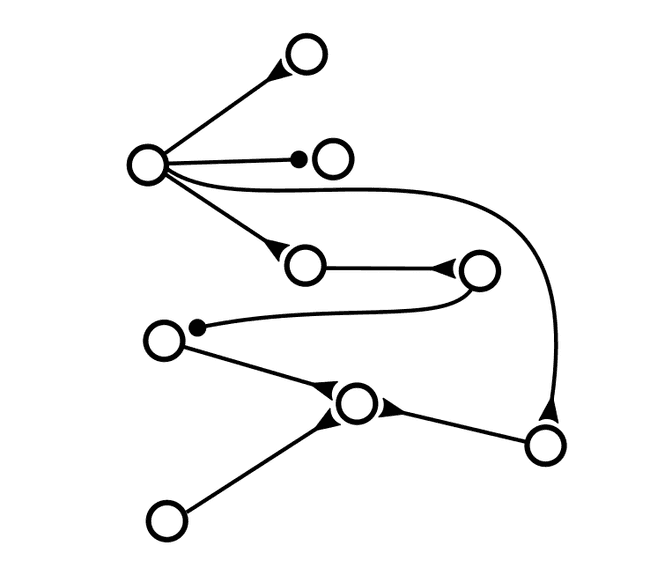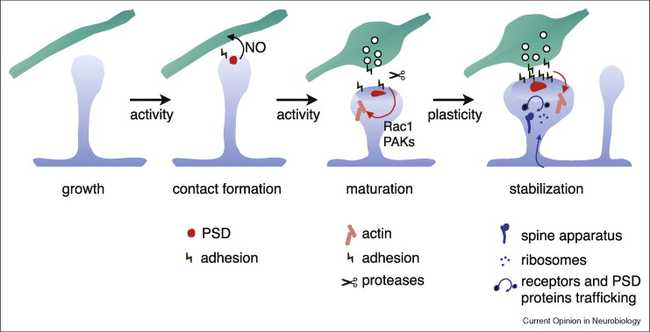The Cart Pole problem was introduced by A.G. Barto, R.S. Sutton, and C.W. Anderson in "Neuronlike adaptive elements that can solve difficult learning control problems". Usually it's solved by Reinforcment Learning
Sutton and Burto wrote the whole book about Reinforcment Learning, so no wonder why their problem is solved this way, but today we will use Spiking Neural Networks to achieve one-shot learning and smooth movements
There's an environment where different implementations can be compared and scored (?). But the same as in original computer simulation from the paper the gym only allows to push the cart with constant force, but at any time interval. Controlling the amount of force will be our second goal.
Design the network
- The graph is not fully connected
- Connections defined randomly and never change (presence of the connection, not its strength)
- Simultaneous connections to layers deep inside the network
- Feedback connections making closed loops
This article about dendrites led me to many important statements.
I searched for pictures of axon to dendrite connections. One lame artist made a picture for sale where many axon terminals from one neuron are connected to many dendrites of another neuron. Is this how synaptic strength can be increased?
a dendritic arbor avoids multiple hits with the same axon, which could multiply not just actual synapses, but also potential ones. Such avoidance results in a statistical repulsion between branches.
Obviously that illustration was a dud. One neuron when excited sends the message to many postsynaptic neurons. Which corresponds to fully connected feed-forward network if we consider a local region in a column (otherwise we should change from fully connected to locally connected in some region).
If spines define synaptic strength, when do we make adjustments to this strength? Constantly.
most spines that appear in adult animals are transient, and the addition of stable spines and synapses is rare.
How many spines per dendritic shaft are we talking about? Some constant amount, but they can appear and disappear.
motor learning induces rapid growth of new dendritic spines at mice contralateral motor cortex neurons, and subsequent elimination of spines existing before training, so the overall spine density is relatively constant
Dendritic Spines Shape Analysis—Classification or Clusterization? Perspective
Answering my questions, How important for different axon terminals (coming from different axons) to be on one dendritic shaft comparing to connections on different shafts
Signaling molecules may spread from active to inactive synapses. [...] the priming effect can spread about 10 μ, thereby sensitizing neighboring spines to an induction stimulus that would otherwise not lead to plasticity.
Spike timing dependent plasticity: a consequence of more fundamental learning rules
Hebbian Rule -> Spike time-dependent plasticity -> Calcium-dependent plasticity link
If you stop the signal, then you stop the whole branch.
In contrast to excitatory synapses, the vast majority of inhibitory synapses are located at the dendritic shaft and the cell body, while only a few inhibitory synapses in the neocortex are spine synapses
Surprisingly, signals can go to nowhere
In the adult rat, 80% of parallel fiber terminals occur on dendritic spines, 9% contact dendritic shafts, and approximately 11% do not have a postsynaptic partner. Moreover, 20% of terminals can be shared by two dendritic spines. [...] a vast majority of the axonal terminals are not motile.
When spines are developed and when they are pruned https://www.frontiersin.org/articles/10.3389/fnsyn.2020.00036/full
Dendritic spine formation and stabilization (no access) https://www.sciencedirect.com/science/article/abs/pii/S0959438809000518
Each muscle fiber is innervated by only one motor neuron but a single motor neuron can innervate multiple muscle fibers.
The total muscle tension is the sum of tension generated by all motor units in the muscle.
Feedback loop
What is a signal and how it propagates through the system? Weights are multipliers or weights characterize the strength of synapse connection? And if strength can be expressed in a value, let's say in a normalized interval , is this value altered by the strength or only the fact of positive value is important? There must be something that not only defined by strength, but by the signal value or its frequency.
...locomotor system is organized such that the spinal CPGs are responsible for producing the basic rhythmic patterns, and that higher-level centers (the motor cortex, cerebellum, and basal ganglia) are responsible for modulating these patterns according to environmental conditions. Such adistributed organization presents several interesting features: (i) It reduces time delays in the motor control loop (rhythms are coordinated with mechanical movements using short feedback loops through the spinal cord). (ii) It dramatically reduces the dimensionality of the descending control signals. Indeed the control signals in general do not need to specify muscle activity
Central pattern generators for locomotion control in animals and robots
Winner-take-all.
In my notebook I wrote, "store emotions in memory". Yeah, I started with emotions as an important drive in decision making. But today I think that the statement is wrong. Emotions are not stored in memory (assuming there is something that reflects memory and storage).
Emotions define neural path to memories.
Central pattern generator
I'll go trough this review in the search of insight about what network design I need to implement in order to create the CPG.
PCA can reduce dimensions of the movements matrix. Okada, M., Tatani, K., & Nakamura, Y. (2002). Polynomial design of the nonlinear dynamics for the brain-like information processing of whole body motion. PDF
Arena, P., Fortuna, L., Frasca, M., & Sicurella, G. (2004). An adaptive, self-organizing dynamical system for hierarchical control of bio-inspired locomotion.
Lewis, M.A., Tenore, F., & Etienne-Cummings, R. (2005). CPG design using inhibitory networks.PDF Self inhibiting neurons make themselves... inhibited. Other cycle parameters are hardcoded. Neurons only used for altering contr cycles. Motors just powered with constant power at specific intervals. Pretty misleading work. Demo
If biological neuron is activated how the brain detects that no synapse connections with its axon exist? Somehow it can enable plasticity and synapses will occur with this neuron. Maybe just after it started to become activated more often?
When a neuron becomes activated more frequently, especially in conjunction with other neurons, it can trigger various mechanisms that promote the formation of new synapses. One such mechanism involves the release of certain signaling molecules, like neurotrophic factors. Also according to Hebbian rule, neurons that fire together wire together, and the connections between them strengthen.
Python playground
C:\Users\neupo\miniconda3\Scripts\activate.bat
conda create -n cartpole python=3.10
conda activate cartpole
pip install notebook
jupyter notebook!pip install gymnasium
import gymnasium as gym
env = gym.make('CartPole-v1')
observation, info = env.reset()
action = env.action_space.sample()
num_actions = env.action_space.n
observation, reward, terminated, truncated, info = env.step(action)
if terminated or truncated:
observation, info = env.reset()
env.close()
